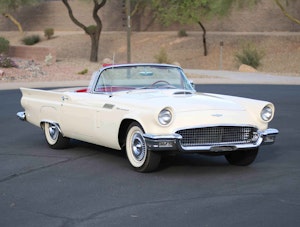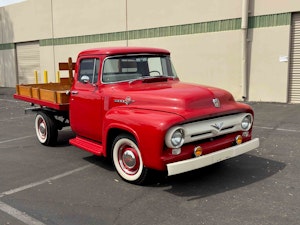Media | Articles
This Chicago-area barn find chaser keeps the memory of forgotten marques alive
Anyone involved in the vintage car hobby is familiar with the “barn find” phenomenon, that slice of automotive folklore in which one discovers a neat car (part of a wild goose chase or otherwise) hidden from the masses. Ryan Brutt, a Mopar-loving chap from the Chicago area, turned his personal hobby into a winning streak that caught the attention of national publications like Mopar Collectors Guide and Hot Rod.
For a number of years, Brutt has showcased his cool discoveries via the “Barn Finds & Hidden Gems” display at the Muscle Car and Corvette Nationals (MCACN) in Chi-Town. Always a huge crowd-pleaser, the 2019 edition of Ryan’s display was no different, dazzling folks of all brand allegiances and keeping alive the memory of Plymouth, Pontiac, and Olds—yes, Virginia, they’re still out there. Here are five of Brutt’s finds, plus more in the gallery.
1970 AMC AMX/3 prototype

The 1969 AMX/2 was an American Motors concept car designed to carry on the torch from the factory AMX two-seater. The fiberglass mid-engine two-seater was non-functional, but when introduced at the 1969 Chicago Auto Show, generated enough buzz for AMC to develop the idea further. Designer Dick Teague and AMC bosses brought the AMX/2 to Italy, where they asked Giorgetto Giugiaro to engineer the updated AMX/3 for limited production consideration. Utilizing a longitudinally-mounted 390-cubic-inch V-8, four-speed transaxle, and chassis development courtesy of Giotto Bizzarrini, the AMX/3 was ready to compete with contemporaries like the DeTomaso Pantera when it debuted in March of 1970. Alas, the world of high performance and safety was changing. Complex logistics—and just general upheaval at AMC—sealed the AMX/3’s fate after only six pre-production prototypes were built. This one, hiding in storage in Michigan, is chassis #1.
1970 Plymouth Sport Fury GT
Marketplace
Buy and sell classics with confidence

Someone forgot to tell Plymouth that full-size performance cars were dead. However, 1970 was the year of the Rapid Transit System, a new team of performance cars in all size classes: compact (Duster 340), pony car (’Cuda), budget performance (Road Runner), upscale performance (GTX), and full-size (Sport Fury GT). The Sport Fury GT came standard with a 350-horsepower 440, wrap-around strobe stripes, and other heavy-duty equipment. It was also the only full-size Mopar to ever receive the 6-Barrel 440. This black example has the standard 440 and was baking in the Kansas sun until 10 years ago when it was rescued and, eventually, picked up by a C-body collector.
1970 Oldsmobile 4-4-2 W30

Greg Lowe’s dad bought this 4-4-2 W30 convertible new, one of 264 built, and drove it daily until 1983. His dad planned on restoring it with Greg and his son, but unfortunately the elder Lowe passed away before the restoration could begin. The 1970 4-4-2 W30 sits atop the Olds food chain as the first of the series built with the 455—after General Motors saw fit to ditch the edict that prevented mid-size vehicles from having an engine displacement above 400 cu-in. However, Oldsmobile had already been building 455-powered performance cars for two years, thanks to Hurst. The standard 455, as installed in the 4-4-2, produced 365 hp, but the W30 package increased it to 370 (on paper) and added a number of features that made it both a performer and a looker.
1970 Pontiac GTO “Humbler”

Ever see that GTO “Humbler” commercial on YouTube that has the Goat cruising through a burger drive-in? The driver pulls a knob and all of a sudden the exhaust note achieves puberty. Cool, right? Well, that car has finally been found, and it made its public debut at the Barn Finds Invitational.
This GTO is actually a pilot car built in May 1969, well before the 1970 model year began. VIN sequence number is 28, while the Fisher Body number on the data plate is #001—yup, the first GTO built! Palladium Silver with a blue interior, the Goat also was powered by the top-dog Ram Air IV engine and sold by Cochran Pontiac in Monroeville, Pennsylvania, in September of 1970. The Vacuum Operated Exhaust option was not available on Ram Air vehicles, but as pilot car, this example featured the option for the TV commercial (although not invoiced for such).
1969 Ford Mustang Mach I

The funny thing about 1969 Mustangs with the 428 Cobra Jet is that they’re less rare than you’d expect—almost 13,000 fastbacks had the Cobra Jet engine, with a large percentage being Mach I examples. A bit over 3000 Cobra Jet fastbacks were ordered with the Drag Pack, which qualified them as Super Cobra Jets. That means your chances of finding one like this Winter Blue Mach I is quite good compared to other cars in the “Barn Finds & Hidden Gems” display. The option list means business: four-speed, 3.91 gears with Traction-Lok, and F70-14 white-letter tires, plus AM radio and an eight-track set.
Which of these do you wish you had discovered? Let us know in the comment section below.
























